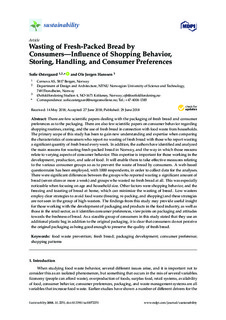| dc.description.abstract | There are few scientific papers dealing with the packaging of fresh bread and consumer preferences as to the packaging. There are also few scientific papers on consumer behavior regarding shopping routines, storing, and the use of fresh bread in connection with food waste from households. The primary scope of this study has been to gain new understanding and expertise when comparing the characteristics of consumers who report no wasting of fresh bread with those who report wasting a significant quantity of fresh bread every week. In addition, the authors have identified and analyzed the main reasons for wasting fresh-packed bread in Norway, and the way in which those reasons relate to varying aspects of consumer behavior. This expertise is important for those working in the development, production, and sale of food. It will enable them to take effective measures relating to the various consumer groups so as to prevent the waste of bread by consumers. A web-based questionnaire has been employed, with 1000 respondents, in order to collect data for the analyses. There were significant differences between the groups who reported wasting a significant amount of bread (seven slices or more a week) and groups who wasted no fresh bread at all. This was especially noticeable when focusing on age and household size. Other factors were shopping behavior, and the freezing and toasting of bread at home, which can minimize the wasting of bread. Low wasters employ clear strategies to avoid food waste (freezing, re-packing, and shopping) and these strategies are not seen in the group of high-wasters. The findings from this study may provide useful insight for those working with the development of packaging and products in the food industry, as well as those in the retail sector, as it identifies consumer preferences, viewpoints on packaging and attitudes towards the freshness of bread. As a sizeable group of consumers in this study stated that they use an additional plastic bag in addition to the original packaging, it is clear that consumers do not perceive the original packaging as being good enough to preserve the quality of fresh bread. | nb_NO |

